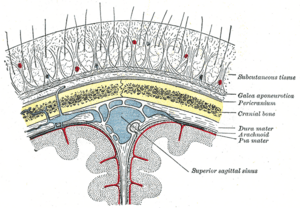Scalp facts for kids
Quick facts for kids Scalp |
|
|---|---|
 |
|
| Illustration depicting the layers of the scalp and meninges | |
 |
|
| Scalp | |
| Latin | scalpus |
| Artery | supratrochlear, supraorbital, superficial temporal, occipital |
| Vein | superficial temporal, posterior auricular, occipital |
| Nerve | supratrochlear, supraorbital, greater occipital, lesser occipital |
| Lymph | occipital, mastoid |
The scalp is the skin and tissue that covers the top of your head. It stretches from your face to your neck. Your scalp protects your skull and brain. It is also where your head hair grows!
The Scalp's Layers
Your scalp has five main layers. You can remember them easily using the word "SCALP" as a mnemonic (a memory trick):
- S: The Skin is the outer layer of your scalp. This is where your hair grows from. It has many tiny blood vessels, which means it gets a lot of blood.
- C: Connective tissue is a thin layer right under your skin. It is made of fat and strong, flexible fibers. This layer helps connect the skin to the deeper parts of your scalp.
- A: The Aponeurosis (also called the galea aponeurotica) is a tough, strong sheet of tissue. It is made of dense fibrous material. This layer helps hold the scalp together.
- L: The Loose areolar connective tissue is a soft, spongy layer. It acts like a cushion and allows the top three layers (Skin, Connective tissue, Aponeurosis) to move easily over the pericranium and skull.
- P: The Pericranium is the deepest layer of the scalp. It is a special covering for your skull bones. The pericranium helps feed the bone and helps it repair itself if it gets damaged. Doctors can sometimes lift this layer to do skull surgery.
See also
 In Spanish: Cuero cabelludo para niños
In Spanish: Cuero cabelludo para niños

All content from Kiddle encyclopedia articles (including the article images and facts) can be freely used under Attribution-ShareAlike license, unless stated otherwise. Cite this article:
Scalp Facts for Kids. Kiddle Encyclopedia.

